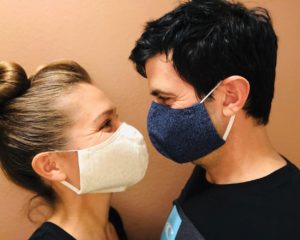There is a sweet matter-of-factness in the way Pauline Hooker describes her seven-decade marriage to her husband, Fred: a lovely wedding, careers, children, and then you blink, and it’s 2020. From moon landings to smart phones, from the baby boom to the birth of rock and roll, we’ve covered a lot of ground in the past 70 years.
Perhaps the teenaged version of Fred and Pauline Hooker couldn’t have imagined what life would be like today, as they celebrate their 70th wedding anniversary on June 24. But for the two teen sweethearts, advancements of time and technology have done nothing to ruffle the focus of their family and their dedication to what has always mattered the most to them – togetherness.

Both born and raised in San Pedro, Fred and Pauline met when the two were barely teenagers, when Pauline transferred to Dana Junior High. “I walked into class as a new student, and I was quite frightened, and this guy, he says, ‘You could come and sit with me,’” Pauline recalls of her first encounter with her future husband. “To me, he was just a flirty guy, so I didn’t pay too much attention. But I also didn’t know anyone at the school, so eventually we became friendly and we started going together, and we dated through junior high and high school.”
The memories of their first years together are hazy for Pauline and Fred (in the way that middle school memories tend to be for anyone past the age of 30), but Pauline remembers long talks on the phone. “We talked on the phone all the time.”
Fred chimes in, “We didn’t get to talk very long. Her mother always stopped us.”
“Well I think we did,” chuckles Pauline. “My folks were very strict so we didn’t really go out, and even going to the show we didn’t do too much.”
The couple graduated from San Pedro High School in 1948 and married in 1950. “We had a beautiful wedding at the old Mary Star,” remembers Pauline. “And quite a big wedding for this town, since we both came from good-sized families. Our reception was at the old Assistance League, and it was really lovely.”
Pauline remembers the young priest who married them and how he cautioned the couple prior to saying their vows. “He would say to us, ‘You are too young, it will never last.’” But the couple was married, (the bride and groom were 19 and 21 years old, respectively), and they stayed in touch with the priest over the years.
“Father Kiefer was his name,” smiles Pauline. “When we celebrated our 50th anniversary, we invited him to renew our vows.” The couple recalls the renewal ceremony and the pride with which Father Kiefer (who, by that time, had become a monsignor) recounted how wrong he was about his original misgivings. “He said, ‘I married these two, and I always told them they were too young for it to last. And you know, this is the first couple that I’ve married and attended a 50th anniversary for,’” Pauline remembers. “That was always special to us.”

After the wedding, Fred and Pauline borrowed her parents’ car, and the newlyweds enjoyed a road trip honeymoon to San Francisco and Yosemite. “And then we came home and lived in a little apartment behind my folks’ home that they owned,” Pauline recounts.
Fred worked at the fish market driving a truck when they were first married, before moving on to jobs at Columbia Steel, then at Douglas Aircraft, and finally at Mobil oil in Torrance where he worked for 31 years, becoming an assistant manager before retiring (for the first time) at the age of 55. He later worked as a contractor until he was 65.
Pauline worked at a local dental office until she was five months pregnant with their first child and left to focus on raising her growing family. “We had our first baby [Julie] in 1951, our second [Denise] in ’55 and our third [Steve] in ’61.” Their family would eventually welcome eight grandchildren and 14 great-grandchildren.
“We all live here in town within five minutes of my mom and dad,” notes their son, Steve. “Before [COVID-19], we would spend every Tuesday and Thursday morning having coffee on their porch and talking. We have kept these visits up but now we’re using video chat, with sometimes eight of us on at once.”

When asked what she thinks is the secret to a long, healthy marriage, Pauline laughs, “I don’t know, really. It was such a different life back then. We were young, and we did not have a lot, but we had our children, and we bought an old house that we would fix up little by little, and I think that was one of the things that brought us together as a family. We had our arguments, but we were together, you know?”
“Sometimes I think that when a couple is in a relationship at such a young age, and they marry young, that they grow up together,” suggests her son, Steve. “Their early life experiences are all shared with someone very close, and that relationship becomes almost like breathing.”
While the secret to their long marriage might be hard to pin down, their steadfast dedication and respect for each other and love for their ever-growing family is palpable when you speak to Fred and Pauline. “My mom and dad often talk of how proud they are of their family,” notes their son, Steve. “My mom looks at our large family picture and says, ‘Look what we did, Fred.’”
Fred celebrated his 91st birthday on May 11, and Pauline will be 90 this September. spt














































